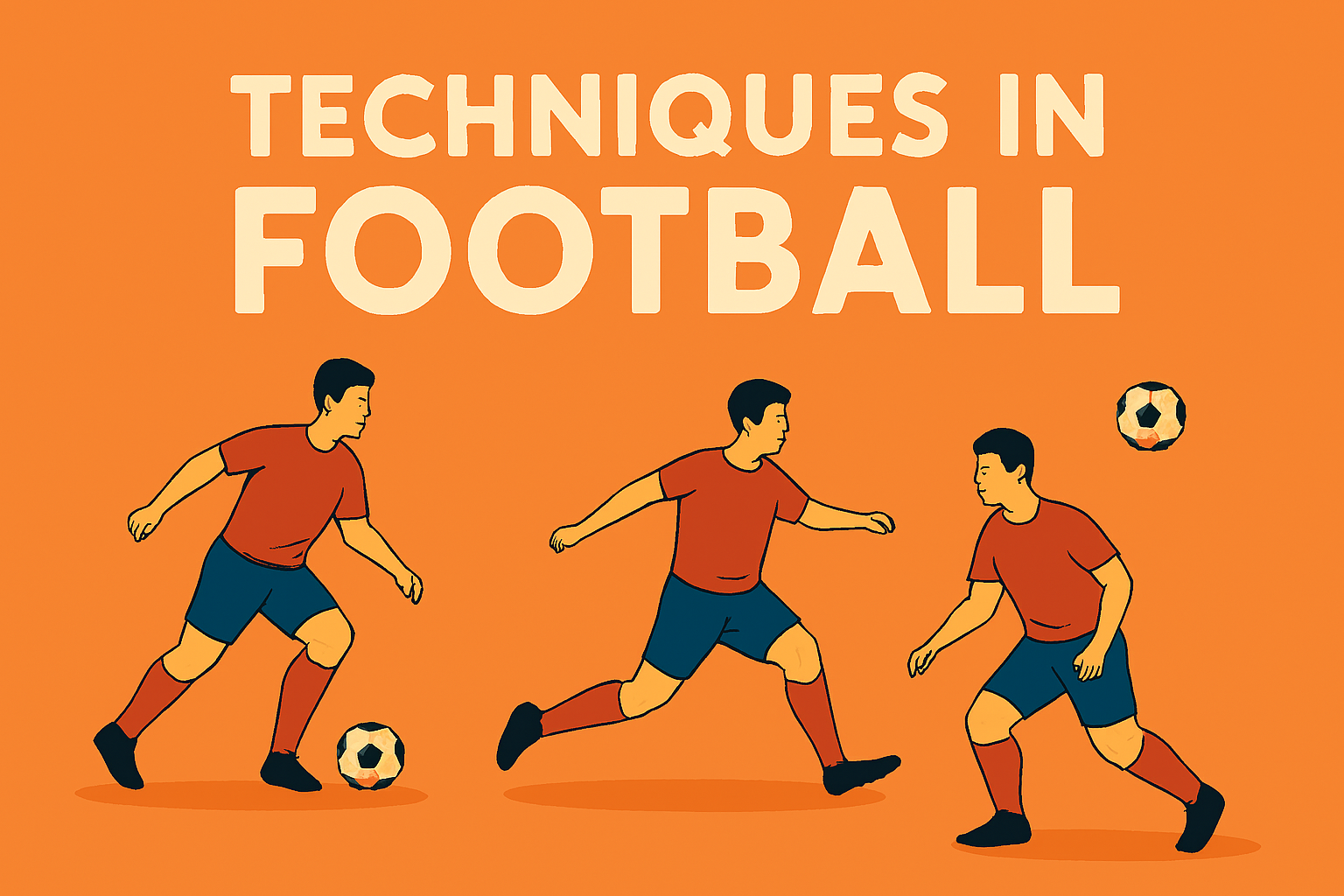Football is fundamentally a technical sport, and coaches emphasize that sessions need to develop the basic techniques of ball control, dribbling, and passing. Legendary coach Arsène Wenger has observed that a player “should know when to dribble and when to pass.” The importance of “technical ability” as the expression of talent, as Wenger believes, suggests that if a player can master these basic techniques, they can then understand how to read the game and make appropriate decisions. Coaches often began youth training with ball-control techniques and basic passing techniques.
Passing Techniques: Fundamentals of Accurate Distribution
Effective passing involves vision, body position, and touch not just kicking power. The FIFA Training Centre highlights that an open body stance and playing on the half-turn allows a player to see more of the field and execute passes into space Players should also focus on a quality first touch that directs the ball away from pressure, so it can be played cleanly into space. Player’s practice developing the skill of placing the standing foot next to the ball (pointed at the target) while following through with the kicking leg; this allows both control of balance and location. We have all seen how passing drills are normally both movement and decision making; keep-away games (rondos) have players looking up and communicating before a pass is made, while wall-pass (one-two) practices develop accuracy on either foot. With time, players develop a dependable passing range, from a firm ground pass to a lofted chip, allowing players to play passes into tight areas and break opposition defenses.
Dribbling Techniques: Close Ball Control and Movement
Dribbling techniques are all about close ball control, quick touches, and creativity. Coaching experts describe “ball mastery” as using the feet, hips, and body to manipulate the ball and beat opponents. When dribbling, players should keep their heads up to read defenders and pick out space ahead. It is critical to use the inside and outside of both feet, taking controlled touches so that the ball stays close. Quick shifts of weight and subtle feints (such as scissors or step-overs) help wrong-foot defenders. During dribbling practice, they also learn to use their body to shield. An example of this is using an arm or hip to hold off a charging opponent. Beginners will often practice “slalom” or obstacle courses for training touch and sharp turns. Eventually, a dribbler will instinctively know when to speed up in open space and when to protect the ball and wait for support. Practicing these basic drills consistently builds confidence and develops instinct to take defenders on.
Shooting Techniques: Finishing with Power and Accuracy
Shooting techniques dictate how a player contacts the ball when attempting to score. Several important elements include using the right part of the foot (laces/instep for power or inside of the foot for placement), body balance, and follow-through aimed directly toward the target. Players are taught to keep their eyes focused on the ball and head down until after contact is made which will assist in ensuring a clean connection. During shooting drills, players have the chance to practice placement, and power. An example would be alternating between the inside of the foot to place the ball in the corner, and the laces to drive the ball forcefully into the net. In team practice, coaches will also recordable introduce volleys and half-volleys to allow for momentary control of the ball with proper contact and timing.
Decision making is also an important aspect of shooting in conjunction with technique. Players must identify the moment they can or should shoot, as opposed to shooting blindly from poor angles. The FIFA coaching resource participants were given advice that players should locate when they have a legitimate chance to score, as opposed to shooting randomly. The mantra is “shoot, move to shoot, or pass to shoot”, meaning a player should always look to create or finish chances whenever possible. In practice, high-quality shooting drills are set up with an emphasis on patience and movement: players circle away and return into striking position, learning to open shooting lanes. Over time, this creates good habits so that when a quality chance arises, the player’s instinct is to strike cleanly and accurately.
Heading Techniques: Timing and Power in the Air
Heading requires different skill than footwork because the head must meet the ball precisely. Players should contact the forehead (the largest part of the skull). The players need to focus on the ball and have stiff neck muscles at the point of contact. coaches talk about timing the jump and positioning the rest of the body so that the player can meet the ball at the highest point. For example, the attacking players adjust the chest and shoulder orientation to meet the ball at the best angle of address for the header. They are trying to aim the ball with their head to the intended target. The attackers practice timing their jump and heading when flying in to meet the ball while keeping their eye on the ball flying in to head with power.
In later sessions, the players participate in game situations for heading: the coach sends crosses or corner kicks so the attacker can time their jump, and the defender can practice clearing the corner. In practice, the technique the player learns for defensive heading often emphasizes safety: meet the ball with force to elevate it away from the goal. Through time and incidental repetitions of skills in game-like scenarios – matching runs, corners, and flick-ons – players develop their timing, contact point, and accuracy (for safety, youth programs may use lighter balls or lessen heading drills for very inexperienced players, although their focus should still be on proper form for heading).

Defending Techniques: Tackling and Interceptions
Defending techniques include tackling, marking, and intercepting. The foundation is timing and awareness. Irene Paredes highlights that a defender must keep their eyes on the ball and position themselves between the attacker and the goal Staying “goal-side” (between the ball and one’s own net) means the defender can both block an attacker’s route and see the play. This positioning, along with tracking the ball instead of the player, means defenders can choose when and how to double check the attacker. For example, defenders are taught to jocke attackers (low center of gravity, shuffling feet) to slow them and direct them to others or less dangerous spaces.
The most basic skill when defending is the tackle and it needs to be done carefully. As Paredes points out, timing is key especially for a sliding tackle because a tackle that times wrong will miss the ball completely or give away a foul. To avoid going into early, defenders are trained to allow the attacker to get a slight touch, then commit when the ball is a bit ahead of the attacker. A clean tackle uses the foot or cleat to meet the ball with either a block tackle (standing) or slide tackle, and the body remains low. When ready to commit fully, the defender uses their legs and power from their core to win the ball.
Coaches always reinforce the proper tackling technique during drills. In 1v1 drills, players decide to perform a standing tackle or slide tackle based on the opponent’s body position. They also practice interceptions so they can read the body of the attacker and step into passing lanes.
Techniques: Putting It All Together
Today’s training for beginners brings all these skills together in an integrated training session. Coaches use various drills and games that combine all the skills such as passing, dribbling, shooting, heading, and defending in realistic situations. Small-sided games provide opportunities for many touches under pressure and require players to exhibit the correct technique with passing, dribbling and shooting. It also demands that players engage in the proper defensive shapes. The emphasis remains on the fundamental skills such that players are still using proper passing technique, having their touches near the ball while dribbling, heading correctly off crosses, and timing their tackles.
By practicing these techniques repeatedly through a variety of drills and match-like situations, players develop perceived confidence and instinct. Integrated practice making decisions about when to pass, dribble, shoot, head or tackle will ensure that the fundamental skills are second nature when the player participates in matches. A solid technical foundation over time empowers each player to create a difference: to create scoring chances through sound technique, and neutralize threats through sound defending, thus contributing to the team’s success overall.
For beginners, the work must recommit to the techniques of these skills in training as a player who attains mastery of the fundamentals early will progress more quickly and develop to be able to play at a higher level.

